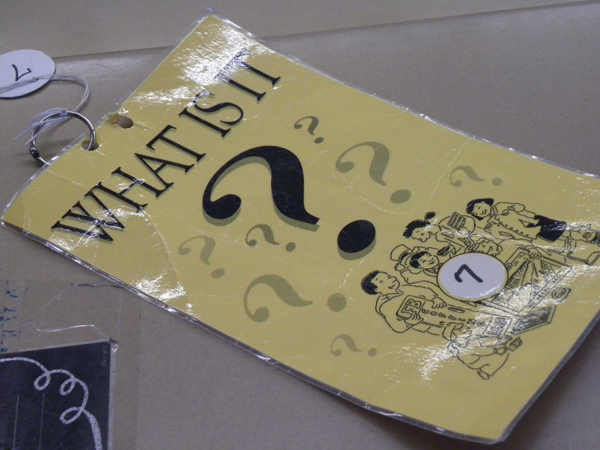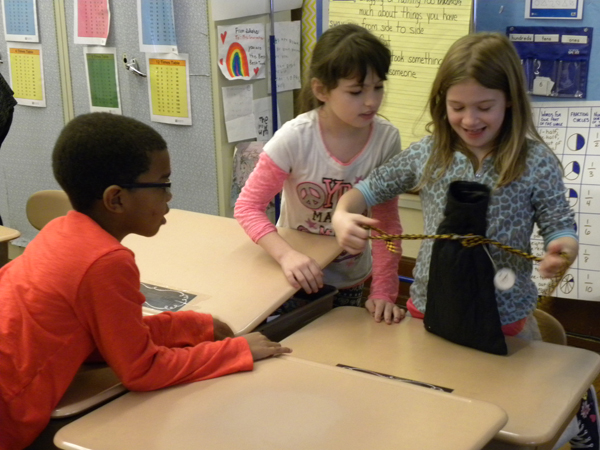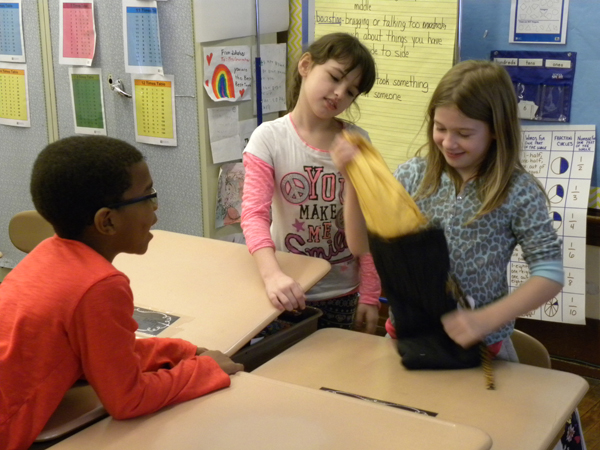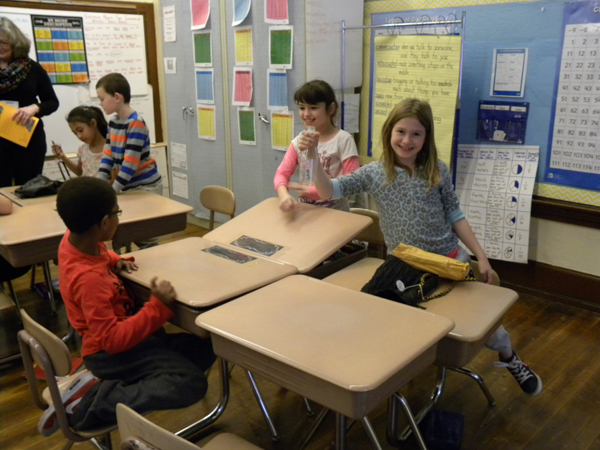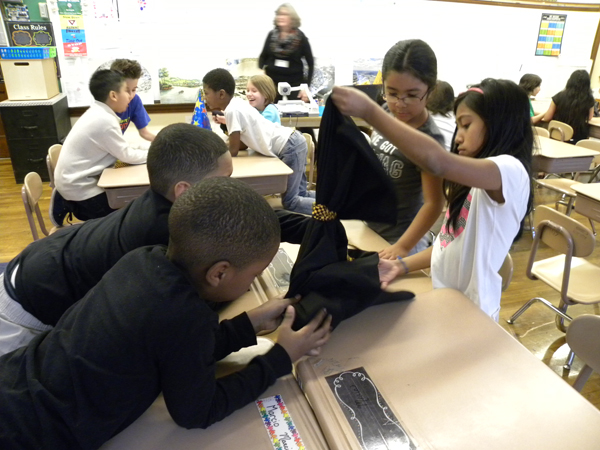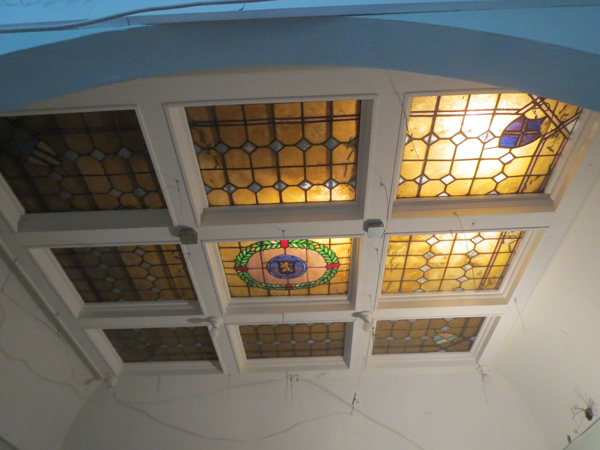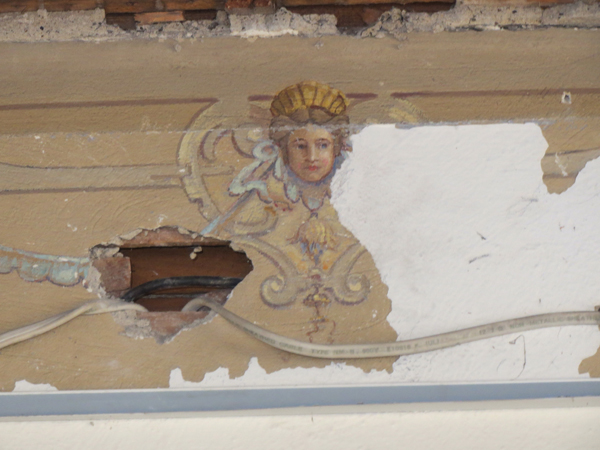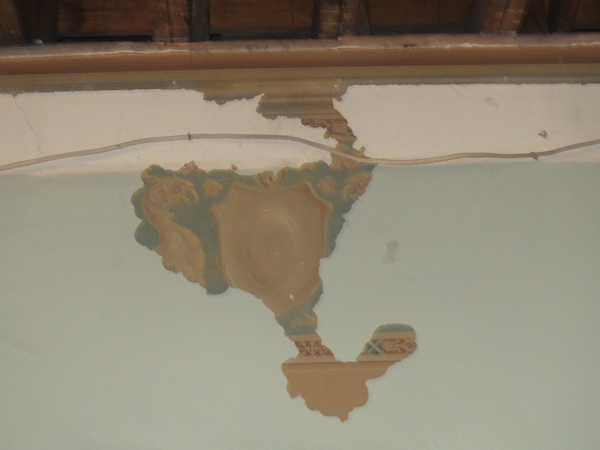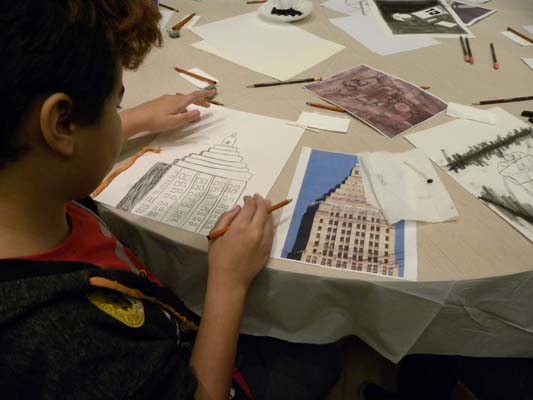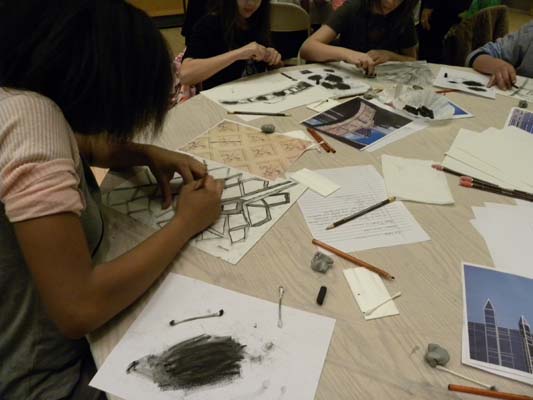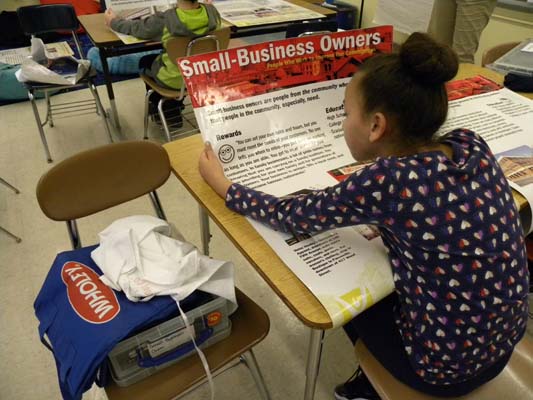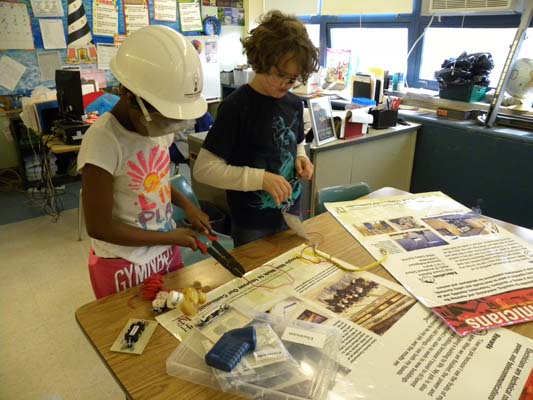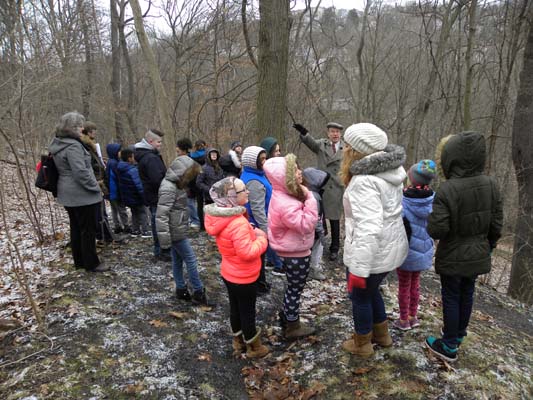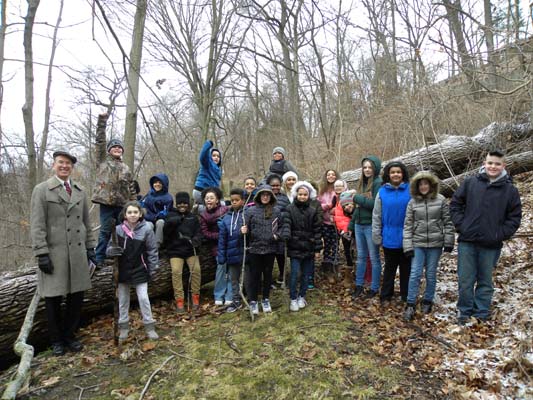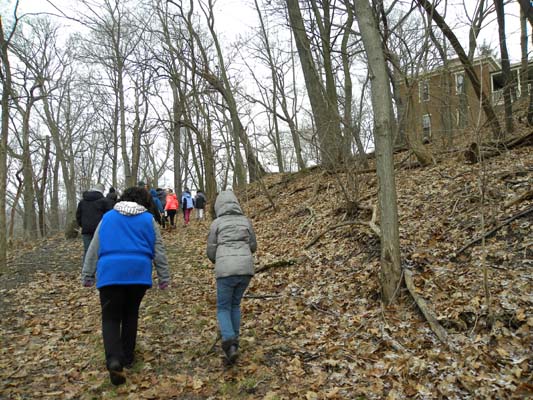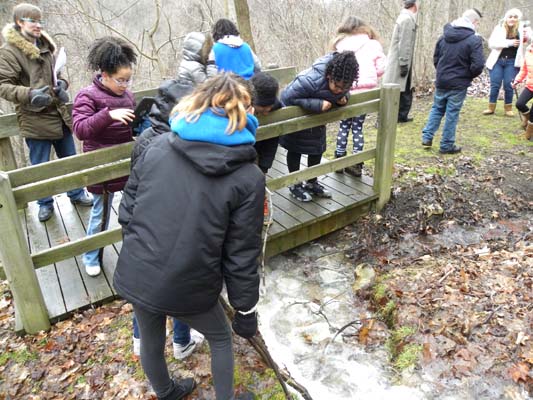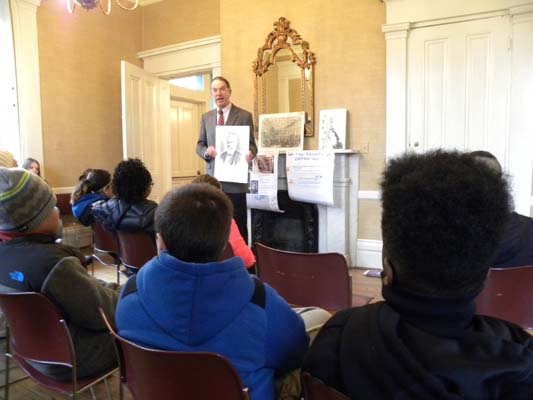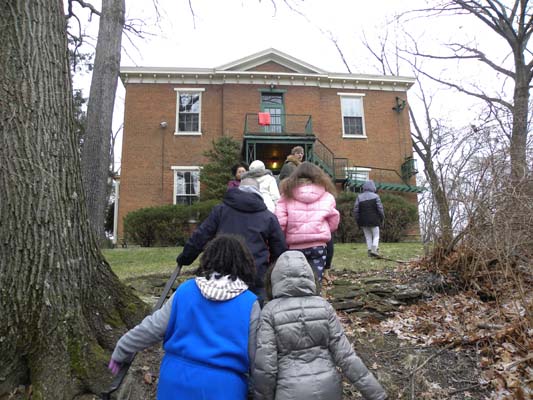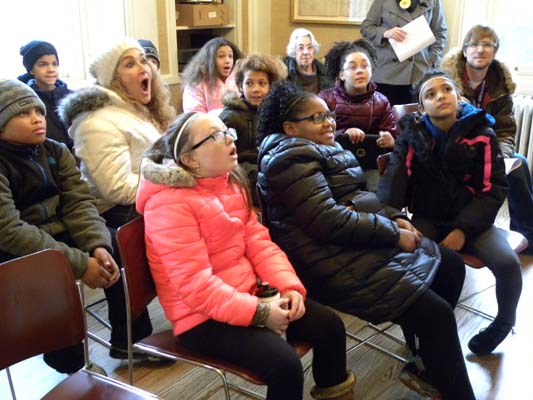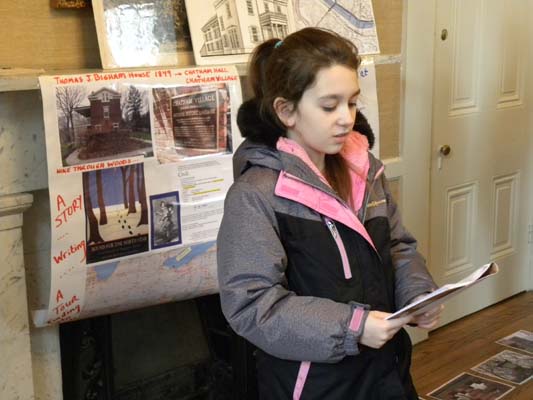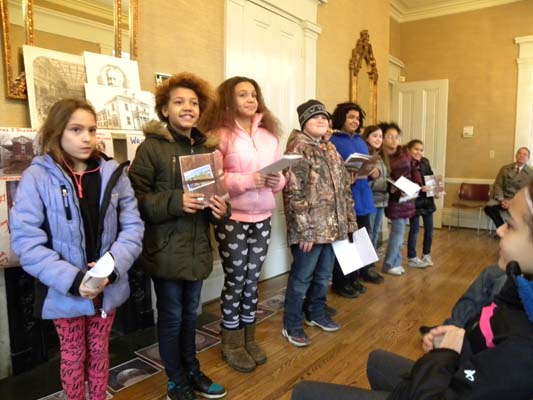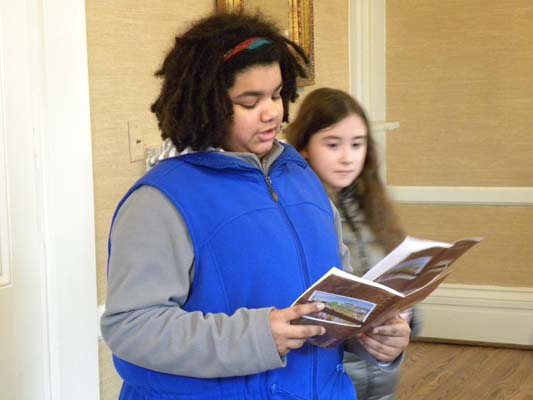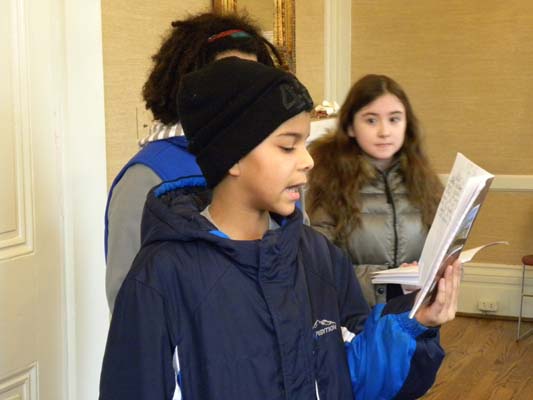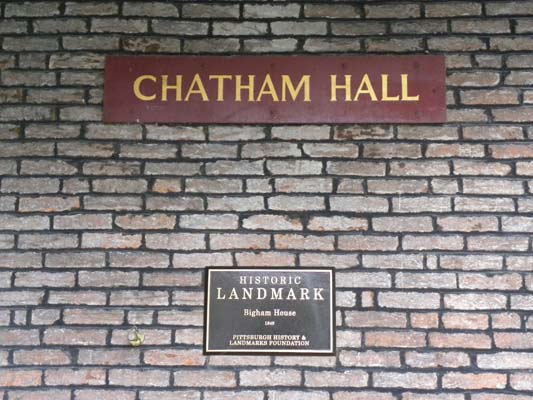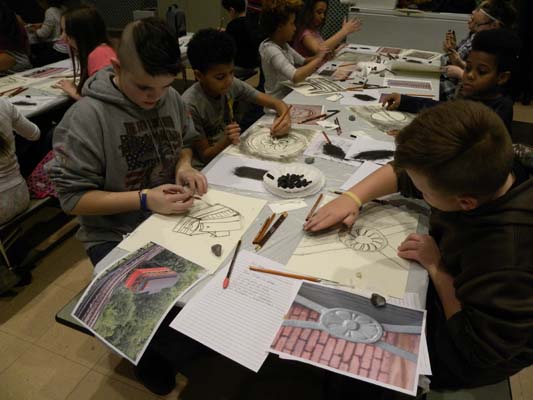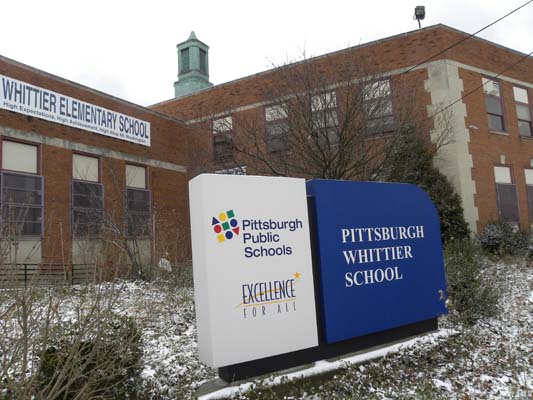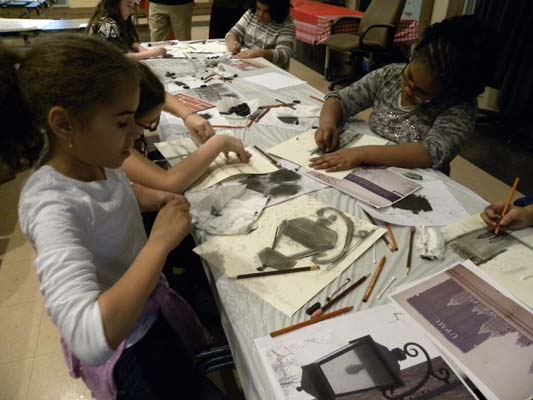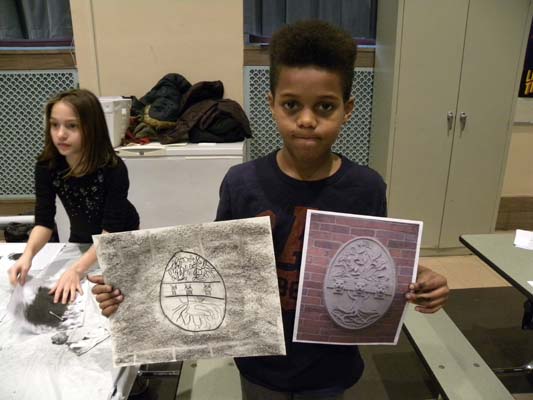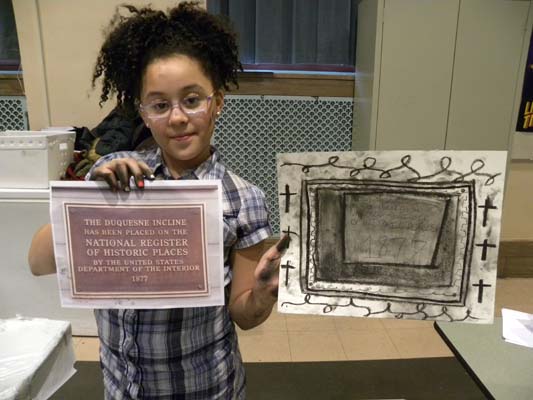
Category Archive: PHLF News
-
Architecture Feature: The Buhl Building
By Albert M. Tannler
The Buhl Building, at 204 Fifth Avenue in downtown Pittsburgh, was designed in 1913 by Pittsburgh architect Benno Janssen (1874-1964), who also designed the white terra cotta addition to Kaufmann’s Department Store in 1913, Pittsburgh’s William Penn Hotel, the Pittsburgh Athletic Association, and Mellon Institute in Oakland, Longue Vue Club in Penn Hills, the E. J. Kaufmann, Sr. house in Fox Chapel, Rolling Rock Stables in Ligonier, and the B. D. Phillips house in Butler.
In Landmark Architecture (1985), PHLF’s architectural historian Walter C. Kidney wrote:
“This is a little gem of a building, clad in blue-creamy-white terra cotta thickly decorated with Renaissance motifs. The color contrast recalls Italian sgraffito work, in which an outer layer of stucco is cut away while still fresh to reveal . . . an inner layer in a contrasting hue. The ground floor has been altered in a Moderne manner.”
In 2009, N & P Properties, LLC, who own the building, undertook a restoration of the upper façade, a refurbishment and reconstruction of the first floor, and construction of a Market Street addition.
As the Moderne façade was removed from the first floor of the Buhl Building, sections of blue and white terra cotta were revealed and above the doorway the original name of the building was visible: Bash Building.
The Buhl Building is in the 1975 Downtown Survey conducted by Pittsburgh History & Landmarks Foundation (PHLF). The survey form stated: “First called the Bash Building, this structure was under construction by mid-1913. Henry Buhl, Jr., bought it in October 1913 while it was still under construction.”
There is no information on the building in the Benno Janssen papers at the Carnegie Mellon University Architecture Archives so I assembled a chronological history of the building using plat maps, city directories, census records, newspapers, and deeds, assisted by researcher John Husack, who was documenting the history of Market Square for PHLF.
Architectural historians Lu Donnelly and Martin Aurand directed me to The Jewish Criterion (1862-1965), available online at http://pjn.library.cmu.edu, which proved to be invaluable. I used both hardcopy and the searchable database of city directories prior to 1940 on the Historic Pittsburgh website at http://digital.library.pitt.edu/pittsburgh. City newspapers were read on microfilm at the Carnegie Library of Pittsburgh.
Here’s what we found.
Real estate mogul Franklin Felix Nicola (1859-1938) is known primarily, Walter Kidney tells us, for his “Bellefield and Schenley Farms development companies [that] transformed a large area in Oakland and provided a setting for much of the city’s best architecture.” On February 2, 1900, Nicola purchased the land and commercial buildings at 200-208 Fifth Avenue.
In 1906 Morris H. Bash opened a fur salon at 202 Fifth Avenue. Bash, who also sold women’s clothing and had a second location at 437 Smithfield Street, operated his businesses with his sons Henry, Louis, and William. Beginning in 1908, the firm is known as M. H. Bash Sons.
On January 30, 1913, Nicola announced that the 200-208 Fifth Ave buildings would be demolished on May 1, 1913, and construction would begin on a new building designed by Benno Janssen. Bash Sons paid for half the cost of constructing the new building and all furnishings; consequently the building would be named the Bash Building. As the principal tenants, Bash Sons were permitted to sublet the space they did not occupy in the building.
On August 11, 1913, while the building was being constructed by James L Stuart Company, Henry Buhl, Jr. purchased the property from Frank Nicola.
Advertisements—illustrated by a perspective drawing—of “The New Home of M.H. Bash Sons” appeared in Pittsburgh newspapers the second week in October. The Bash Building opened on October 13, 1913. In late 1915 or early 1916 the Bash firm declared bankruptcy. Their stock was liquidated by the Frank & Seder Department Store.
From 1917 to 1921, both names—Bash Building and Buhl Building, 204 Fifth Avenue—were listed in city directories. In 1922 the building became the Buhl Building. Henry Bash was able to remain in business and he retained a retail space in the Buhl, née Bash, Building for some years thereafter.
N &P Properties, LLC will donate a preservation easement on the Buhl Building to PHLF guaranteeing that the Buhl Building façade will be preserved for future generations.
-
Free Guided Tours of Historic Oakmont Country Club
Mondays, from 8:45 a.m. – 10:30 a.m.
- April 10 and 24
- May 1 and 15
- June 5 and 19
- July 10 and 24
- August 7 and 21
- September 11 and 25
- October 9 and 23
- November 6 and 20
- December 4 and 18
The tour is free. Donations are welcome, with the proceeds going to the Oakmont Country Club (OCC) Archives Committee to further advance the tour experience.
Advance reservations are required; limit of twelve individuals per tour.
For reservations, contact Oakmont Country Club: 412-828-8000
Few golf courses in the world have the fabled history of Oakmont Country Club, a National Historic Landmark and host of nineteen major championships to date. Now, you can tour the historic clubhouse and golf course on certain Monday mornings, April through December.
Participants will be guided through our handsomely preserved 113-year-old clubhouse by one of our golf historians. Learn about the founding of the club in 1903 and the family that made it all possible. A stroll down History Hall illustrates the history of the US Open at Oakmont, with historic photographs, memorabilia, and championship artifacts. Gaze upon our collection of USGA trophies and see the original men’s locker room.
Weather permitting, guests will tour the historic “inland links” golf course and see the extraordinary vistas, narrow fairways, treacherous sand bunkers, and iconic “Church Pew” bunker. Guests will also have the opportunity to test their putting skills on Oakmont’s world-renowned putting surfaces.
The tour ends at the Oakmont Professional Shop, where guests may browse through a wonderful selection of apparel, equipment, and memorabilia only available at Oakmont Country Club.
Additional details:
- Please arrive at Oakmont Country Club by 8:45 a.m. (light refreshments provided)
- Casual attire (no jeans or denim) and comfortable walking shoes with flat sole. Coat or jacket depending on weather forecast. Umbrellas will be provided.
- Disabled access is available.
- Photography is permitted.
- For further information about the tour, contact the OCC Archives: 412-828-8000, ext. 257 or archives@gmail.com
Tours are sponsored by the Fownes Foundation, a 501(c)(3) organization dedicated to the restoration and preservation of nationally recognized, historically significant golf sites.
-
A Young Preservationist Determined to Learn a Trade
By Haley Roberts
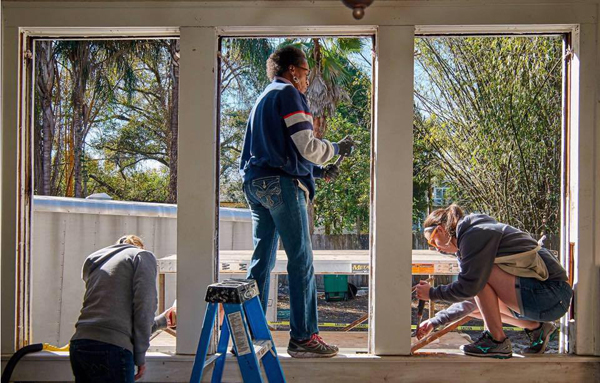
Haley Roberts, on the far right in the picture, spent an academic year as a Landmarks Fellow at PHLF, and recently took a preservation demonstration course on restoring windows.
I have been an advocate for historic preservation for many years. I can talk anyone’s ear off about the historical significance of a place, and I can run an economic analysis to prove that a historic structure is a good investment for families or developers. However, in spite of those valuable skills, I still felt hypocritical in demanding the preservation of historic properties in Pittsburgh for one very good reason.
I could not actually DO historic preservation.
By that, I mean that I had no experience in the preservation trades like plaster repair, repointing masonry, or—my personal interest—wood window restoration. How could I possibly expect Pittsburgh residents to be good stewards of their historic homes if I had no idea how to maintain them myself?
I became determined to learn a trade. I chose to tackle window restoration specifically because windows, in my opinion, are the eyes into the soul of a home. Through them, people can see the spirit, passion, and craftsmanship that was poured into the construction of an older building. However, with an ever-decreasing supply of window restoration specialists, original wood windows in historic homes are at risk for being swapped out for vinyl replacements. When that occurs, these homes lose a significant part of their charm.
In trying to learn about wood windows through YouTube videos and blogs, I stumbled across the Historic Homes Workshop, an event in Tampa hosted by a local window restoration company called Wood Window Makeover that teaches people, step by step, how to repair wood windows. This nine-day intensive training consisted of two “classroom” days – one to learn the process of restoring a window, and the other to become an EPA-certified renovator – and two multi-day, hands-on projects where I put my knowledge to the test under the mentorship of window restorers from across the country.
During the workshop, I pulled window sashes out of their frames and restored the functionality of their rope and pulley mechanisms. I scraped layers of paint off of 100 year-old window jambs. I took wavy glass panes out of these windows and re-glazed them. I even learned to paint without painter’s tape and to use lots of different saws! All the while, I was networking with preservationists in Michigan, Ohio, Florida, Georgia, and many other states who shared their experiences, tactics, and struggles in protecting historic architecture in their hometowns.
I was thrilled to develop all of these skills and meet new people, but perhaps the most valuable thing I walked away with from the Historic Homes Workshop was an appreciation for the love and craftsmanship that went into wood windows when they were originally installed. I would have never known how rewarding working on windows can be without this hands-on experience. It only made my passion for historic preservation that much stronger.
As a result of the Historic Homes Workshop in Tampa, I feel confident that I can restore historic wood windows from start to finish. I cannot wait to start sharing my knowledge and advancing historic preservation efforts through preservation-specific trades here in Pittsburgh.
-
Featuring Architect William George Burns
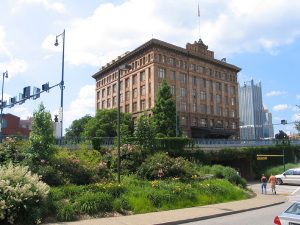 This is the best preserved of the large Pittsburgh railway stations still extant [containing] some 80,000 feet of floor space. . . . Designed in 1898 by William George Burns, it was completed in 1901. . . . On the interior the great waiting room is undoubtedly, after the foyer of the Carnegie Music Hall, the finest Edwardian space extant in Pittsburgh. The staircase that descends into the room like a waterfall is especially noteworthy and the ornate detail that adorns this great two-story hall contributes a general air of subdued cruscating [sparkling] richness to the whole convoluted space. Every effort should be made to preserve this elegant structure. —— James D. Van Trump, Landmark Architecture of Allegheny County, Pennsylvania (1967)
This is the best preserved of the large Pittsburgh railway stations still extant [containing] some 80,000 feet of floor space. . . . Designed in 1898 by William George Burns, it was completed in 1901. . . . On the interior the great waiting room is undoubtedly, after the foyer of the Carnegie Music Hall, the finest Edwardian space extant in Pittsburgh. The staircase that descends into the room like a waterfall is especially noteworthy and the ornate detail that adorns this great two-story hall contributes a general air of subdued cruscating [sparkling] richness to the whole convoluted space. Every effort should be made to preserve this elegant structure. —— James D. Van Trump, Landmark Architecture of Allegheny County, Pennsylvania (1967)By Albert M. Tannler
PHLF Historical Collections DirectorIn the main, William George Burns should be considered a Canadian architect. He was born in Toronto, Canada, on either August 1, 1870 (according to Biographical Dictionary of Architects in Canada 1850-1950 (2009-2016) or in July 1871 (according to US Federal Census 1900), worked as a carpenter in Toronto in 1887, worked as an apprentice to architect Mancel Willmot (1853-1934) from 1888-1892 and subsequently worked as a draftsman for architect William G. Storm (1826-1892).
Burns came to America either in 1892 (according to the 1900 Federal Census) or in 1895 (according to Biographical Dictionary of Architects in Canada 1800-1950) which states “He left Canada in 1895 and went to New York City where he obtained further education before moving to Pittsburgh, Penn.” Burns’ work in Pittsburgh has been documented and spans 1898-1904. He first appears in Pittsburgh directories in 1899 in two entries: Wm G. Burns is listed as a draftsman, living at 12 Stockton Avenue, Allegheny, while G. W. Burns, architect, appears at the same address. He resided in Allegheny (1899), Beaver (1900), and Sewickley (1901-04). In 1901 Burns formed a partnership with Charles H. Craig and Harvey Childs Hodgens in the firm of Craig, Hodgens & Burns (1901-02), later Hodgens & Burns (1903-04).
Three of Burns’ projects in Western Pennsylvania have been documented: the Lincoln Hotel, (demolished); the John Snyder residence, Beaver, Pa., 1901; and the first and most important: the P&LE RR Station in Pittsburgh, 1898-1901.
Biographical Dictionary of Architects in Canada 1800-1950 notes that Burns “was fortunate enough to obtain a position as Staff Architect for the Pittsburgh & Lake Erie Rail Road in 1899 and was given the opportunity to design the P. & L.E. Railroad Station, Smithfield Street at Carson Street, PITTSBURGH, PENN., 1898-1901. . . . The significant Beaux-Arts landmark integrated commercial offices, passenger arrival and departure halls, and train sheds into one complex, and the Grand Concourse is now considered one of the finest interior public spaces in Pittsburgh.” The waiting room was decorated by Crossman & Sturdy, 287 Michigan Ave., a Chicago firm established in 1893. Their design for the P.&L.E. waiting room was published in the 1900 and 1903 Pittsburgh Architectural Club Exhibition catalogs.
Around 1905 Burns returned to Toronto and opened his own architecture practice. Among his documented works between 1905 and 1916 are nine houses (including his own); two churches and a Sunday school; and a factory. He left the architectural profession after 1922 and worked in real estate and construction before retiring. He died on November 23, 1949.
-
Scholarship Opportunity for High School Seniors
Thanks to funding support from PHLF’s Brashear Family Named Fund, the McSwigan Family Foundation, and many other donors, PHLF offers a scholarship program for high-achieving, community-minded, high-school seniors in Allegheny County who will be attending college or university in the fall of 2017.
“The Landmarks Scholarship recognizes students who have achieved academic excellence and possess the potential to make a difference in the Pittsburgh community and beyond,” said David Brashear, a PHLF trustee and the program founder. “The students selected by our committee already feel connected to the city and its history and will hopefully continue to serve the region as leaders in promoting PHLF’s values.”
Since 1999, PHLF has awarded scholarships to 64 students who care deeply about the Pittsburgh region. The scholarship award of $6,000, payable over four years to the recipient’s college or university, is for book and tuition expenses only.
Click here to learn more about the eligibility requirements and criteria and to download an application. The application deadline is Wednesday, April 19, 2017.
-
“Portable Pittsburgh” Builds Hometown Pride and Knowledge
“The children really need an understanding of where they live in this world. Portable Pittsburgh supplements our unit studies.” ––Pittsburgh Public School teacher
Karen Cahall, PHLF’s education coordinator, helps third-grade students understand how Pittsburgh has grown and changed over time by having them unwrap “mystery artifacts” and by showing them images of Pittsburgh from 1765 until 2014. Through her hands-on discussion and interactive presentation, students are able to “visualize the progression of time in Pittsburgh and understand how people lived throughout the years,” according to one teacher.
Portable Pittsburgh is one of the programs PHLF presents to Pittsburgh Public Schools through its “Building Pride/Building Character” program, offered through the state’s Educational Improvement Tax Credit (EITC) program. Contributions from the following corporations and private foundations are funding PHLF’s programming in 2016-17:
Lead:
- First National Bank of Pennsylvania
- McSwigan Family Foundation
- Alfred M. Oppenheimer Memorial Fund of The Pittsburgh Foundation
- PNC Bank
Patrons:
- Eat’n Park Hospitality Group, Inc.
- Frank B. Fuhrer Wholesale Company
- Huntington Bank
Partners:
- Hefren-Tillotson, Inc.
- Maher Duessel, CPA
- C. S. McKee, LP
- UPMC
-
Renovation of the Historical Society of Mount Lebanon’s Building Reveals Surprising Discoveries
The Historical Society of Mount Lebanon is creating a permanent history center for the community in a Mediterranean-inspired building at 794 Washington Road. The stucco home was constructed in the late 1920s or early 1930s. Original stained glass and stenciling have been discovered in the course of restoration work.
During the past several months, Ramp Construction Company has replaced and reinforced the existing roof, removed hazardous material, and demolished walls and ceilings in certain areas of the house in order to create larger spaces for the history center. The front porch has been rebuilt to match a photo from the late 1940s or early 1950s. Five new skylights have been installed in the roof to illuminate the nine stained-glass panels in the ceiling of one of the first-floor rooms. Williams Stained Glass Studio is in the process of cleaning and restoring these panels. (The skylight illuminating these stained-glass panels was removed sometime after 1982.) Funding for this first phase of the restoration was made possible through a grant by the Redevelopment Authority of Allegheny County and the Commonwealth Financing Authority.
When the contractors removed some of the crown molding in the dining and living rooms, they discovered stenciling. The stenciling uncovered in the dining room is about 12 inches deep. Boris Brindar, the chief conservator for A. J. Vater & Company, has revealed hand-painted details of a woman wearing a tiara. What was found under the paint in the living room is even more spectacular! A decorative wall mural seems to be about 30 inches deep, extending down from the ceiling. The pattern probably repeats itself along this living-room wall. On the wall directly opposite, is another hand-painted design, also about 30 inches deep. There is a crest, flanked on each side by a bird (maybe a griffon?). In the middle of the crest are the faint markings of the letter “O”.
Society members have discovered that Edward J. and Laura M. Ohl bought the lot and built the house in the late 1920s or early 1930s. Therefore, this stenciling/decorative art on the walls is most likely original to the house. None of this stenciling appears in any photos the Society has from the McMillan family, who were the third owners. Dr. Donald McMillan and his wife, Christine, purchased the house in 1946 and lived there until 1982. They had four children, and Dr. McMillan had his office on the lower level, accessible from Lebanon Avenue.
The Society plans to incorporate the cost of restoring the original stenciling in its total project budget. In the next phase, Joel Cluskey of RSH Architects will restore the interior spaces so the Society can occupy and operate on the first-floor. The Society has a long way to go to secure funding for the remainder of the project. If you know of some person, corporation, or fund that may be interested in naming opportunities, please send an email to info@lebohistory.org. Thank you!
-
12 Pittsburgh Public Schools Participate in “Building Pride/Building Character,” Thanks to Foundation and Corporate Support
In mid-January, PHLF received a $10,000 grant from the Alfred M. Oppenheimer Memorial Fund of The Pittsburgh Foundation that closed the funding gap needed to support its “Building Pride/Building Character” educational program.
“This generous grant, when combined with the $39,500 that we received from eight corporate contributors through the state’s Educational Improvement Tax Credit (EITC) program, will make it possible for us to involve students (grades 3 – 8) from 12 Pittsburgh Public Schools in creative, engaging field trips and in-school programs over the next several months,” said PHLF Executive Director Louise Sturgess.
We thank the following for contributing to PHLF’s “Building Pride/Building Character” educational program in 2016-17:
Lead:
- First National Bank of Pennsylvania
- Alfred M. Oppenheimer Memorial Fund of The Pittsburgh Foundation
- PNC Bank
Patrons:
- Eat’n Park Hospitality Group, Inc.
- Frank B. Fuhrer Wholesale Company
- Huntington Bank
Partners:
- Hefren-Tillotson, Inc.
- Maher Duessel, CPA,
- S. McKee, LP
In addition, the McSwigan Family Foundation and others provide needed support for PHLF’s educational programs.
Below is a gallery of photos of third, fourth, and fifth-grade students from Pittsburgh Beechwood, Minadeo, and Whittier, who participated in PHLF’s career-awareness program and poetry and art programs in January.
Distinguished Pittsburgh poet Samuel Hazo spoke to Pittsburgh Beechwood students during their poetry and art field trip to Carnegie Mellon University on January 26. He explained to students that in poetry “You are called upon to give something it’s right name––it’s not easy to do. Take words seriously for what they sound like, for what they suggest, and for the colors that they assume when they are next to another word.” It was an honor to have Dr. Hazo with us, explaining the art of poetry and assisting students with their individual poems.
The poetry and art program for Pittsburgh Whittier students on January 27 was especially designed to connect to the school’s Mt. Washington neighborhood and to the theme of civil rights. The fifth-graders walked along a wooded path to the Bigham house in Chatham Village, which was a stop on the “underground railroad” in the 1850s. Once back at school, they wrote poems and drew architectural details of neighborhood landmarks.
When asked to think about his experience that day, one student wrote: “I think all the kids loved walking the trail to the Bigham house. We loved learning about Mt. Washington history and poetry and art. My experience was good. I hope you continue this program. Please do.”
Another student added: “I liked walking in the woods because I felt very free. I learned about the escaped slaves and that they walked on the same route as we walked. I would recommend this program for everyone in Pennsylvania.”
We are grateful to the eight corporations and to the McSwigan Family Foundation and Alfred M. Oppenheimer Memorial Fund of The Pittsburgh Foundation for making these enriching “hands-on and eyes-on activities” possible.


